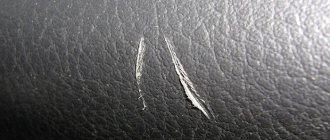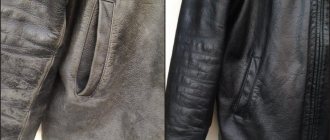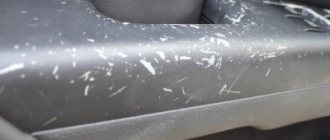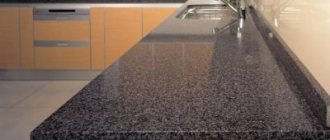Even the most careful driver will not be able to avoid scratches on the plastic parts of the car.
You can ignore them, or you can try to bring the damaged elements back to normal.
Read the article about how and with what means to remove minor abrasions and deep scratches from the plastic outside and inside the car.
Types of scratches on car plastic
Information about the types of damage allows you to come up with the most optimal solution that will quickly and efficiently eliminate scratches and other irregularities.
Therefore they distinguish:
- Minor scratches. Perhaps getting rid of them is as easy as shelling pears, since they do not cause significant harm to the material itself, except perhaps only affecting its appearance.
- Deep scratches. Working with them is considered quite difficult, since they require more attention and care.
- Deformation and loss of color due to contact with direct sunlight. Due to UV rays, the surface of the plastic becomes discolored.
To solve such a problem, a major overhaul is always necessary.
Features of surface treatment outside and inside the car
To process parts located inside the passenger compartment, do not use polishes and abrasive compounds intended for car body care. They contain particles that can disrupt the structure of the product and deteriorate its appearance.
It is always more convenient to carry out work from the outside than from the inside , since it is possible to gain full access for high-quality polishing or heating.
The parts located in the cabin are made of softer plastic and are often coated with gloss. Therefore, they can only be polished with soft, non-abrasive materials.
Plastic body and bumper panels are made primarily from thermoset plastic alloyed with propylene or fiberglass. This ensures their strength, so abrasive grinding attachments are used to remove scratches from them, which will be detrimental to interior plastic.
When a full renovation is required
Unfortunately, it is not always possible to solve the problem quickly and inexpensively. There are situations when the damage is so great that it is simply impossible to cope with it on your own. In this case, you have to turn to the experts.
To avoid serious expenses when you do not have enough experience to determine the level of the problem and the degree of unsuitability of the plastic, pay attention to the following circumstances:
- The damaged part has several cracks at once;
- The extent of the damage covers most of the part;
- The plastic was deformed under the influence of sunlight;
- In addition to the presence of scratches, the affected area has lost its color due to prolonged contact with open sunlight;
- The structure and shape of the surface of a part that has lost its presentable appearance has changed.
All these points indicate that it is impossible to fix the problem on your own.
A full repair involves the complete replacement of old plastic with a new one or its restoration. The plastic is sanded, primed and then coated with a paint composition of the desired color.
Best driving instructors:
Driving instructor Elena Automatic transmission: Chevrolet LacettiTeaches in the Southern Administrative District, South-Eastern Administrative District, Vidnoye, Domodedovo REVIEWS
Driving instructor Marina Automatic transmission: Kia Cerato Manual transmission: Chevrolet LanosTeaches in the Northern Administrative Okrug, Dolgoprudny REVIEWS
Automotive instructor Irina Automatic transmission: Kia Cerato Trains in SZAO, JSC REVIEWS
Driving instructor Natalya Automatic transmission: Kia Spectra Teaches in the Eastern Administrative District, Balashikha, Reutov REVIEWS
Driving instructor Oleg Automatic transmission: Chevrolet Lacetti Manual transmission: Chevrolet LanosTeaches in the Northern Administrative District, Dolgoprudny REVIEWS
Driving instructor Yana Automatic transmission: Kia Spectra Teaches in the Northern Administrative Okrug, Dolgoprudny REVIEWS
Driving instructor Yulia Automatic transmission: Chevrolet Lacetti Manual transmission: Chevrolet LanosTrains in the Eastern Administrative District, South-Eastern Administrative District, Lyubertsy, Reutov, Zheleznodorozhny REVIEWS
Automotive instructor Svetlana Automatic transmission: Chevrolet Lacetti Trains at Northwestern Administrative Okrug REVIEWS
Driving instructor Tatyana Manual transmission: Chevrolet Lanos Automatic transmission: Kia SpectrTeaches in Krasnogorsk REVIEWS
Driving instructor Peter Manual: Daewoo Nexia Trains at Northwestern Administrative Okrug REVIEWS
Automotive instructor Oksana Automatic transmission: Hyundai Accent Teaches in North-Eastern Administrative District, Mytishchi, Korolev, Pushkin REVIEWS
Driving instructor Dmitry Automatic transmission: Volkswagen Golf Manual transmission: Chevrolet Lanos Trains in North-East Administrative District, Northern Administrative District, North-Western Administrative District, Dolgoprudny REVIEWS
Driving instructor Oksana Automatic transmission: Kia Spectra Manual transmission: Chevrolet Lanos Trains in the Southern Administrative District, South-Western Administrative District, Vidnoye, Podolsk REVIEWS
Automotive instructor Dmitry Manual transmission: Lada Granta Teaches in the South-East Administrative District, Lyubertsy REVIEWS
How to get rid of small scratches
Small scratches and cracks are the easiest to repair. You can use wax or machine oil for this. They are good to use in combination with special microfiber cloths. It is necessary to rub the composition in small circular movements.
It's also a good idea to use glass cleaner. The principle of eliminating damage is the same. Abrasive glass polishes help remove scratches, not just hide them for a while.
You can use special gels and polishes for wood. They can also be used to work with plastic, however, in this case you will need to take additional Vaseline.
Using polishes and gels
If microfiber does not give results, gels and polishes are used. The composition is applied to cotton wool; when rubbed, fragments of the gel fall into the recesses and cover them. After 30-50 minutes the polish will harden. Use abrasive pastes, a grinding machine or a rag.
Instructions:
- Apply a thin layer of polish to a clean area and rub it with felt.
- After the appearance of a light gray layer, polishing is performed until the abrasions disappear.
- You can’t wait too long; the dry mixture doesn’t grind well.
- The panels are sanded to a shine.
- The remaining polish is removed and the plastic is washed.
The glossy and transparent coating quickly becomes scuffed.
Using a special pencil
Wax pencils are good in cases where scratches are present on painted plastic. Polishes will be helpless here, but wax, on the contrary, will come in handy.
You can purchase such pencils at any car supply store. Their advantages also include the fact that they are produced in different colors. Therefore, choosing the right shade will not be difficult.
- This pencil is easy to use. You just need to degrease the surface in advance and apply wax over it. And there will be no trace left of the scratch. The principle is that wax fills microcracks in the plastic and paints over the desired area.
- There is an option to use another type of pencils, which contain a special coloring composition. Its choice requires a more careful selection, since the difference in shades between paint and plastic will be very noticeable.
The principle of operation is the same as with wax.
Automotive restorers
Restorers for automotive plastics are various gel-like substances and polishes that allow you to remove damage that appeared during the repair process of the product. After polishing, the part regains its original structure. This treatment is especially important for glossy surfaces.
When using a polish or gel, it is necessary to use an abrasive cloth or a grinding machine. When performing the procedure, you must ensure that the machine operates at minimum speed so that the plastic is not damaged by high temperature. It is also worth remembering that these materials are not designed to eliminate minor scratches. To do this, you should use painting, which we will talk about a little later.
Work on scratches is carried out according to the following scheme:
- The product is cleaned of dirt (washed using special products for processing plastic);
- The surface is completely dry;
- Before processing, the part is degreased;
- The necessary product is applied;
- The part is polished using a grinder until a shine appears.
This technique is used to process glossy plastic - small scratches are removed.
Removing scratches with a lighter
Using a lighter helps heat the surface of the plastic so that you can easily and quietly remove scratches. However, a small clarification should be made: for such an action you need a turbo lighter, that is, one that does not have the red part of the flame. It is distinguished from a regular lighter by its stable blue flame.
The sequence of actions is as follows:
- You bring the lighter to the desired place.
- Burn the scratch several times. That is, the burning time of the fire should be no longer than one second.
- Do this until the plastic warms up enough for the scratch to disappear on its own.
Never touch the heated area with your finger or any other object.
- Firstly, you risk getting burned.
- Secondly, you deform the surface.
This method is only effective if you are dealing with smooth plastic.
Progressive
You can also tidy up the interior of your car using specialized products, such as polishes. To remove unevenness, you will have to use it several times. Don't forget to buy a soft cloth so you don't have to smooth the surface with your hands. Removing scratches begins with spraying the contents of the can onto the desired surface. Afterwards you need to wait a little and rub the scratch area with a cloth. Scratches should become less noticeable. Still not satisfied with the appearance of the torpedo or other area? Then let's use the can again. You need to spray the product on the plastic until a certain result is obtained, not forgetting to polish each time. If the repair is carried out by the car owner, you will have to work a lot with your hands. Has the effect been achieved? Such cosmetic repairs can be repeated later.
Other scratch removal methods
Here it is worth making a small clarification: it is preferable to use expensive products whose action is aimed at restoring damaged plastic.
Therefore, there are several options:
- Cover the surface with a special varnish and paint: for this you will not need too much coloring agent. Moreover, a bottle of paint always comes with a brush. After painting, the desired area is varnished.
- Using vinyl film: the essence of this method is to cover the desired part with a special film and then heat it with a hairdryer. That is, with the help of hot air, vinyl gradually envelops the damaged surface and masks all problem areas. However, in order for everything to work out as accurately as possible, you will need to practice.
- Reupholstering panels using leather: this method makes it possible to carry out a full restyling, since for inexperienced owners it will not be possible to replace only certain elements of leather. Moreover, this method is only appropriate if the interior of your car is leather.
Polishing
The safest and most effective repair of car plastic is polishing. It will require a special dispersant. Do not use pastes to polish the car body - they will only further damage the plastic. Repairs can be carried out manually or using a machine.
It is important to know! High speeds of the grinding wheel can overheat and damage the plastic, so without proper experience it is better to polish by hand.











